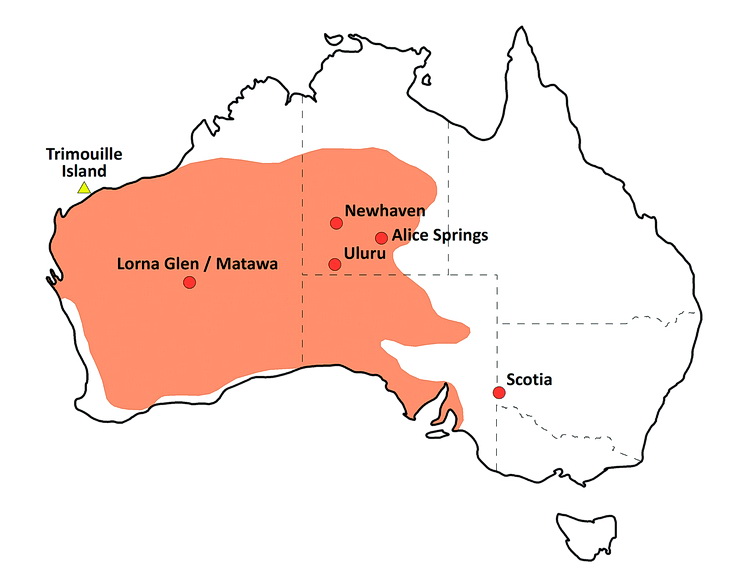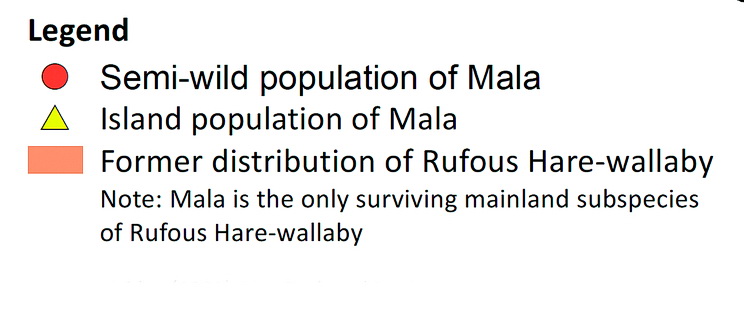By Dympna Cullen, Field Ecologist, and Dr Leah Kemp, Senior Wildlife Ecologist
The return of the Mala (also known as the Rufous Hare-wallaby) to Newhaven Wildlife Sanctuary launched a globally significant program to reintroduce 10 threatened mammal species to central Australia. Now, more of the endangered marsupials are bound for the Northern Territory.
Before the last wild population of Mala (Lagorchestes hirsutus) was wiped out in 1991 by feral predators and wildfire, a few individuals from the Tanami Desert were saved and put into a captive breeding program. From there, a number of ‘insurance populations’ of Mala were established in feral predator-free areas, including at AWC’s Scotia Wildlife Sanctuary, in New South Wales. There are now an estimated 400 Mala on the mainland, plus an introduced population to Trimouille Island, Western Australia, of about 900 animals. These populations are all that remain of this marsupial, which was once abundant across much of central and western Australia (see map).
One of the insurance populations of Mala was established at Watarrka National Park in the Northern Territory, but after wildfires cleared their habitat, the Mala became easy prey for aerial predators. In August 2017, the NT Government requested an emergency translocation of the surviving Mala to Newhaven Wildlife Sanctuary in response to a marked decline in the population.
AWC sprang in to action, successfully translocating 27 Mala from Watarrka to Newhaven in November and December 2017. The Mala were relocated to the safety of a specially built, feral predator-free area.
The return of Mala to Newhaven Wildlife Sanctuary holds special significance for the Ngalia Warlpiri and Luritja Traditional Owners. An important Dreaming site of the Mala lies on the southern boundary of the property.
The Mala were given a few months to settle in and, in May 2018, AWC ecologists conducted health checks and surveyed the population. Nearly all the original 27 animals from Watarrka were re-trapped as well as an unmarked Mala that was likely to have been in the pouch at the time of translocation. This was a fantastic outcome confirming the successful transition of the translocated Mala to their new home.
To help maintain the genetic diversity of the Mala population at Newhaven, 15 males and 15 females from Scotia Wildlife Sanctuary were translocated in June 2018. Under the cover of night and to encourage mixing of Scotia and Watarrka animals, Scotia males were released in one area of the Mala-kurlangu (Warlpiri for “home of the Mala”) and females in another. As Mala are nocturnal, releasing them at night gives them an opportunity to familiarise themselves with their new surroundings, assess the available habitat and find a suitable spinifex hummock before dawn.
The Newhaven Stage 1 feral predator eradication is nearing completion. So far, 44 cats and two foxes have been removed from the area and the AWC Land Management team alongside Newhaven Warlpiri Rangers have been intensively tracking the last few individual feral predators. The 9,390 hectare area, surrounded by a 44 kilometre fence, will only be declared predator-free following several months of post-eradication monitoring.
The translocation of the final cohort of Scotia Mala to Newhaven Wildlife Sanctuary is scheduled for mid-2019. In time, we expect the population will increase to more than 2,000 individuals representing an increase of at least 60 per cent of the total global Mala population.
Over the next few years,11 nationally threatened mammals that once occupied the spinifex plains and rocky escarpments of central Australia will be returned to Newhaven. In addition to Mala, among the first species to be reintroduced to Newhaven will be the Greater Bilby, Golden Bandicoot and the Central Rock Rat, if we can obtain sufficient founders. The return of these species will not only significantly increase the numbers of some of Australia’s most threatened mammals but will also help restore ecosystem processes on Newhaven.
 © AWC
© AWC
